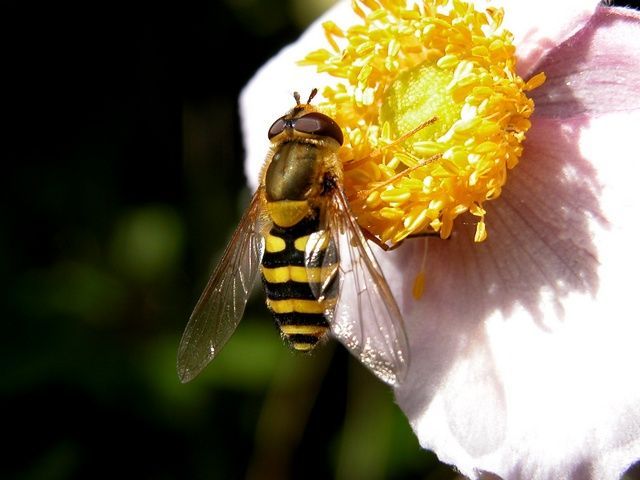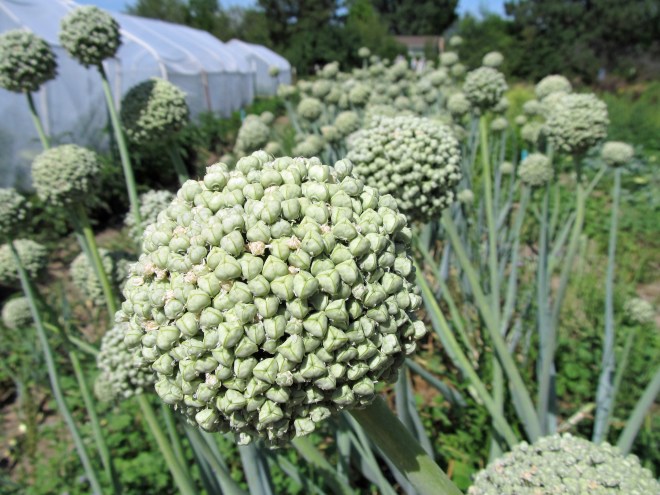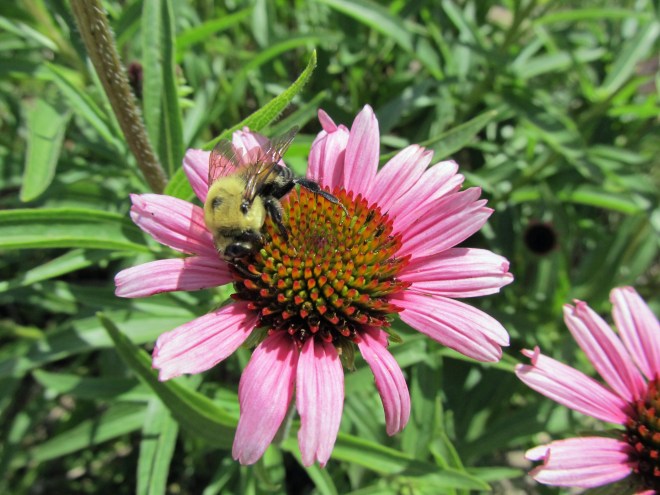Last week I had the privilege of attending a pollinator walk with a local entomologist at Earthly Delights Farm, a small, urban farm in Boise, Idaho. The entomologist was Dr. Karen Strickler, an adjunct instructor at College of Western Idaho and the owner of Pollinator Paradise. A small group of us spent a couple of hours wandering through the farm looking for pollinators and discussing whatever pollinator or non-pollinator related topic that arose. Earthly Delights Farm, along with growing and selling produce using a subscription-based model, is a seed producing farm (and part of a larger seed growing operation called Snake River Seed Cooperative), so there were several crops flowering on the farm that would typically be removed at other farms before reaching that stage, such as lettuce and carrots. The farm also shares property with Draggin’ Wing High Desert Nursery, a nursery specializing in water efficient plants for the Intermountain West, which has a large demonstration area full of flowering plants. Thus, pollinators were present in abundance.

A series of isolation tents placed over various crops to help prevent cross pollination between varieties – an important component of seed saving.
While many groups of pollinators were discussed, including leafcutter bees, bumblebees, honeybees, sweat bees, hummingbirds, and beetles, much of our conversation and search was focused on syrphid flies. Flies are an often underappreciated and overlooked group of pollinators. While not all of the 120,000 species of flies in the world are pollinators, many of them are. The book Attracting Native Pollinators by the Xerces Society has this to say about flies: “With their reputation as generalist foragers, no nests to provision, and sometimes sparsely haired bodies, flies don’t get much credit as significant pollinators. Despite this reputation, they are often important pollinators in natural ecosystems for specific plants, and occasionally for human food plants.” They are especially important pollinators in the Arctic and in alpine regions, because unlike bees, they do not maintain nests, which means they use less energy and require less nectar, making them more fit for colder climates.
One food crop that flies are particularly efficient at pollinating is carrots. According the Xerces Society, carrot flowers are “not a favorite of managed honeybees.” Most flies do not have long tubular, sucking mouthparts, so they search for nectar in small, shallow flowers that appear in clusters, such as plants in the mint, carrot, and brassica families. Flower-visiting flies come in search of nectar and sometimes pollen for energy and reproduction. While acquiring these meals they can at times inadvertently collect pollen on their bodies and transfer it to adjacent flowers. They are generally not as efficient at moving pollen as other pollinators are, but they can get the job done.

Blister beetle on carrot flowers (a preferred food source of flies). Beetles can be effective pollinators as well, even despite chewing on the flowers as they proceed.
During the pollinator walk, we were specifically observing flies in the family Syrphidae, which are commonly known as flower flies, hoverflies, or syrphid flies. Many flies in this family mimic the coloring of bees and wasps, and thus are easily confused as such. Appearing as a bee or wasp is a form of protection from predators, who typically steer clear from these insects to avoid being stung. The larvae of syrphid flies often feed on insects, a trait that can be an added benefit for farmers and gardeners, particularly when their prey includes pest insects like aphids. Other families of flies that are important pollinators include Bombyliidae (bee flies), Acroceridae (small-headed flies), Muscidae (house flies), and Tachinidae (tachinid flies).

Common banded hoverfly (Syrphus ribesii) – one species of thousands in the syrphid fly family, a common and diverse family of flower-visiting flies (photo credit: www.eol.org)
Because many species of flies visit flowers and because those flies commonly mimic the appearance of bees and wasps, it can be difficult to tell these insects apart. Observing the following features will help you determine what you are looking at.
- Wings – flies have two; bees have four (look closely though because the forewings and hindwings of bees are attached with a series of hooks called hamuli making them appear as one)
- Hairs – flies are generally less hairy than bees
- Eyes – the eyes of flies are usually quite large and in the front of their heads; the eyes of bees are more towards the sides of their heads
- Antennae – flies have shorter, stubbier antennae compared to bees; the antennae of flies also have bristles at the tips
- Bees, unlike flies, have features on their legs and abdomens designed for collecting pollen; however, some flies have mimics of these features
Another interesting topic that Dr. Strickler addressed was the growing popularity of insect hotels – structures big and small that are fashioned out of a variety of natural materials and intended to house a variety of insects including pollinators. There is a concern that many insect hotels, while functioning nicely as a piece of garden artwork, often offer little in the way of habitat for beneficial insects and instead house pest insects such as earwigs. Also, insect hotels that are inhabited by bees and other pollinators may actually become breeding grounds for pests and diseases that harm these insects. It is advised that these houses be cleaned or replaced regularly to avoid the build up of such issues. Learn more about the proper construction and maintenance of insect hotels in this article from Pacific Horticulture.

A row of onions setting seed at Earthly Delights Farm. Onions are another crop that is commonly pollinated by flies.

